Public Piers — No Fishing License Required
I first heard about the Pier J piers at the end of 2020. Given that I’ve been to the opening of a couple of piers, I was hoping to be one of the first anglers to fish on these small piers when I visited on January 31, 2021. Alas, they were still closed. The word was that they would open on February 10. No fishing that day but some good pictures of Long Beach, the harbor area, and snow capped mountains in the distance.
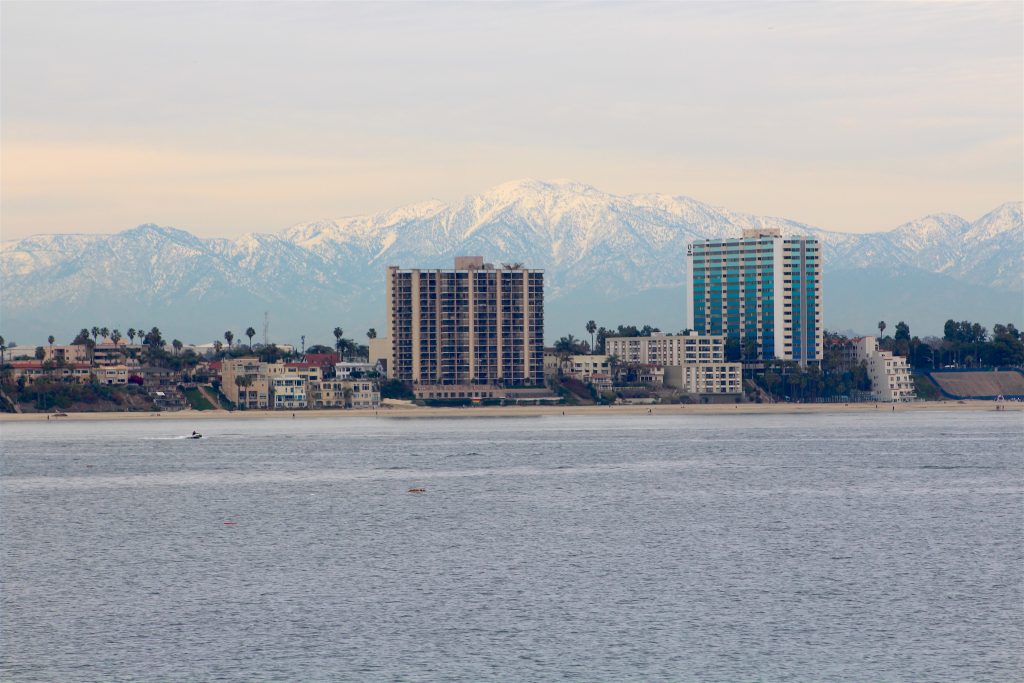

I couldn’t be there in February but I was making a second trip to the area in March, which would allow a visit. Alas a drive by showed red tape across the front of the pier and a sign indicating it was still closed.

When would it open? For a number of reasons I could not return until October when I finally found the pier open and fished it for the first time. It would be my 129th saltwater fished in California.
The piers are somewhat unique, it isn’t often that a pier sits atop another pier but that is basically the story with these two small mini-piers that sit on Pier J in Long Beach.
Pier J itself is one of eleven large “piers” that make up the Port of Long Beach, the second busiest container port in the United States. Each pier serves as an industrial terminal for different companies. Pier J and its 385-acres houses the Pacific Container Terminal, Basin Six and the Southeast Basin. A constant stream of trucks sometimes seems to follow you in and out of the area.
Given its location, the port has also provided a “scenic” drive that parallels the water on the outermost side of the pier. It’s a long drive with a rocky lined shoreline on one side and the industrial, port area on the other side of the street.

The area offers great views of Long Beach, the shoreline headed east toward Orange County, and of course the San Pedro Bay itself. It is also just a short distance down shore from both the iconic Queen Mary (now a hotel) and the Carnival Cruise Port (in the inverted dome that once protected the “Spruce Goose,” Howard Hugh’s famous plane). A cruise ship is often seen sitting at the port.
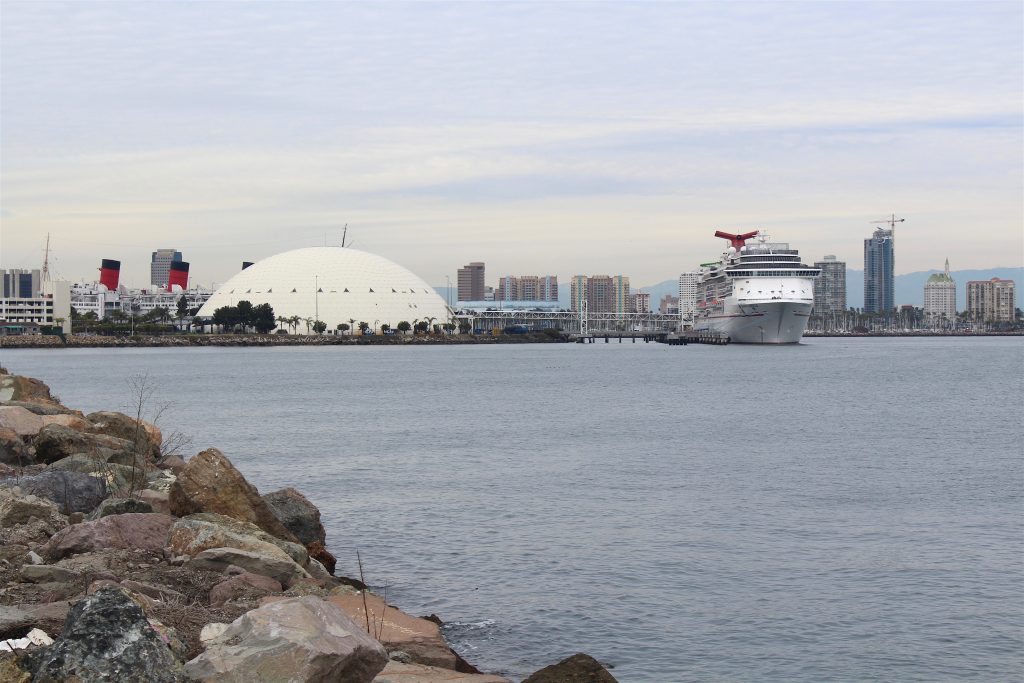


The area has been a long time gathering spot for families and anglers with anglers fishing from the rocks, an iffy and sometimes dangerous proposition for some. The two piers, one a main pier to the east that has adjacent bathrooms, and a second pier further west, provide safer platforms for anglers to fish. Platforms may be a more proper name since both piers stick out horizontal to the shoreline and have no pilings.
Environment: The small piers sit near the outer section of the rocky shoreline that protects Pier J close to Queensway Bay and where the Los Angeles River enters the larger San Pedro Bay. In the distance, straight out from the piers, sit the oil islands—Island White, Island Freeman and Island Chaffee all inside the protected waters of the Long Beach Breakwater.



Two environments are presented the angler. The first is to fish close to the rocky shoreline for the rocky shore species while the second is to cast out into the deeper waters that produce more sandy/muddy bottom species along with more pelagics. The water for the most part is relatively protected and calm.

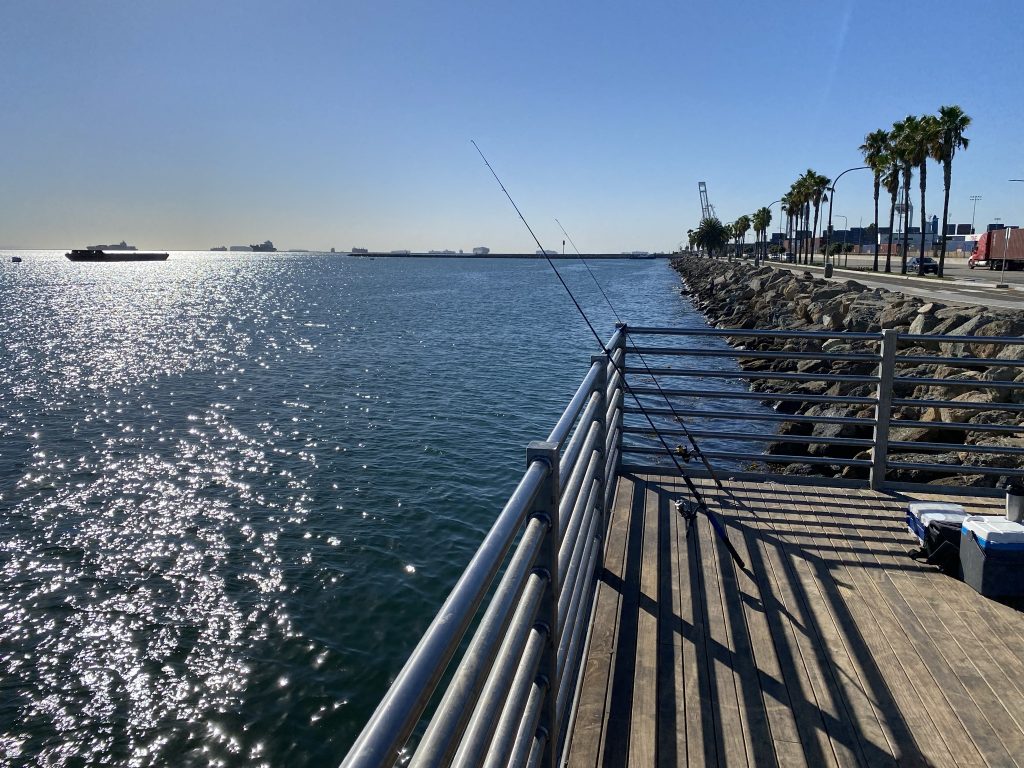
Fish: Casting straight out from the pier mainly yields white croaker (aka tomcod or kingfish), queenfish (aka herring), sargo, halibut, jacksmelt, mackerel and (some months) bonito. At night, anglers may see an occasional barracuda.

Fishing closer to the rocks should yield a variety of bass—kelp (calico) bass, sand bass and spotted bay bass, along with some perch and an occasional opaleye, halfmoon or rockfish.

Sharays are also in these waters. The most common rays are bat rays although some round stingrays and shovelnose sharks (guitarfish) will also make an appearance. The primary sharks that are seen are leopard sharks and gray smoothhounds, although a variety of sharks can make an appearance including horn sharks, swell sharks, dogfish, and even thresher sharks (although few fish for them here).
Fishing Tips: Bait or lures. Most anglers, unless they are specifically fishing for bass, will use bait.
Casting out and using a high/low rigging with a light 2-3 ounce sinker, number 6-4 J hooks, and cut anchovies, cut squid, or saltwater worms should yield the small croakers and sharays if they are around. You can cast out, relax, and sit back to wait for a bite but the better technique is to cast out, let the bait settle to the bottom, and then immediately start a very slow retrieve back to the pier. Fish will often follow the bait almost until it starts to leave the bottom before striking.
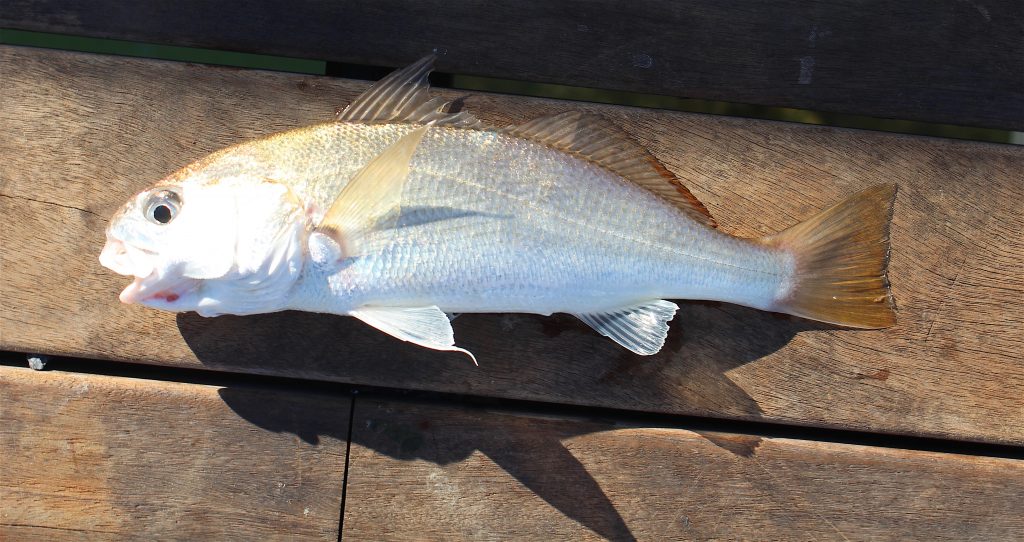
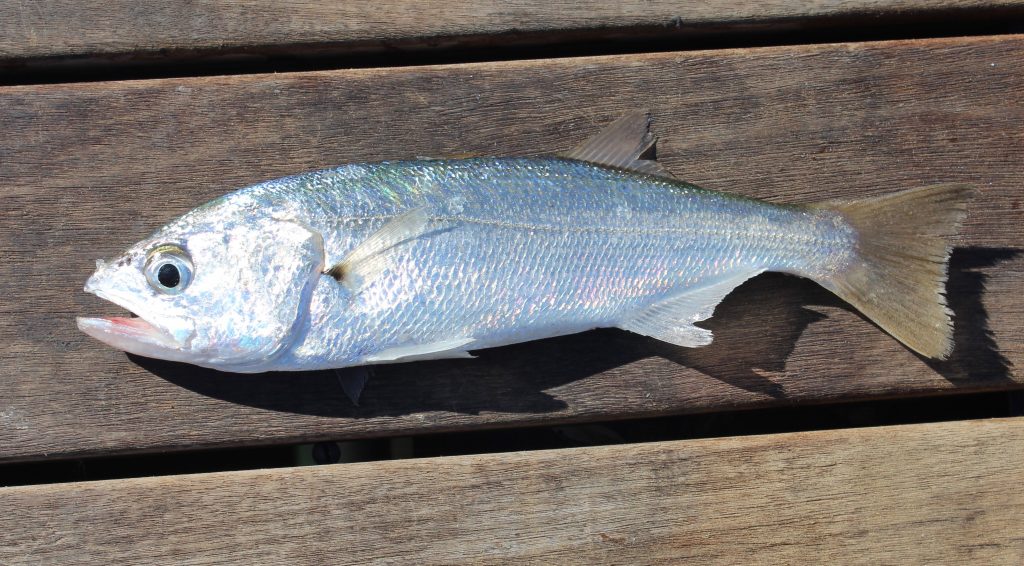
Using a little larger Kahle hook or Octopus hook with ghost shrimp can yield all of the above and are excellent for the larger croakers. For the ghost shrimp I usually let them sit on the bottom instead of retrieving them.
A Carolina rigging with a live smelt or ghost shrimp may yield a halibut. Mackerel and jacksmelt may hit on a Sabiki but the same high/low baited with strips of squid or cut mackerel can also be deadly.
Casting inshore along the rocky shoreline with the same high/low rig but baited with worms, mussel, ghost shrimp or even pieces of market shrimp may yield croaker (yellowfin and spotfin), sargo, perch (walleye, blackperch and whiteperch), bass and small rockfish.

Some anglers prefer using lures. Casting straight out from the pier with a Fish Trap lure, Berkeley Gulp Jerk Shads (while color) and Zoom Flukes (white colored) with a drop shot rigging may produce a halibut. Casing closer to the rocks with lures like Big Hammer and Fish Traps will often produce bass, all three varieties.
Prime time for the halibut is May to October, for the large croaker July through August, and for the larger perch December thru April. Sharays can be caught year round but usually are better in the May through October months. White croaker can be common throughout the year, as can the various bass.
Pier J Facts
Hours: Sunup to 11 p.m.
Facilities: There is limited free parking near at the foot of each pier and trashcans close to the front of the piers. There are no benches, no lights, fish cleaning facilities, or cutting boards. Signs indicate no overhead casting, no diving, and no fish cleaning. Four restrooms are available near the front of the larger, easternmost pier.
Handicapped Facilities: None. The pier surface is wood and the railing is approximately 40 inches high.
How To Get There: From I-710 follow the signs saying S. Harbor Scenic Drive. From downtown Long Beach follow Queens Way past the Catalina Landing and on to the Queens Way Bridge over the water and take the S. Harbor Scenic Drive.
Management: City of Long Beach; Department of Parks and Recreation.

I used to fish pure Jay many many moons ago I’m 70 now I was going out there when I was gone 13 14 years old then he used to stay all night build a fire they even had a big truck come out there like a lunch truck and we caught a lot of fish big Bonita barracudas bass halibut it was all happening a lot back then it’s a little slower but still fun
i love sound of sea
Pier J in Long Beach is one of my favorite spots!
Pier J in Long Beach is a wonderful destination. It’s a great place to fish, and the views are spectacular.
Thanks for sharing this! Next time I’m in Long Beach I will surely visit this wonderful Pier!
I’ve always wanted to explore great fishing spots,
and after reading about it, I’m definitely planning to visit.
If you’re interested in discovering some of the best locations for fishing,
you can View details about them here. This website offers a ton of useful tips and insights for anyone looking to enjoy a day by the water.
Don’t miss out! Pier Fishing
I used to fish out on the pier many years ago, and it’s great to reminisce about those times!
Back when I was 13 or 14, we’d spend all night fishing, build a fire, and sometimes even have a lunch truck roll by. We caught everything from big Bonita and barracudas to halibut and bass. Things have slowed down a bit, but it’s still an amazing experience. If you’re looking for more info on pier fishing, be sure to (View details){https://prayertimesksa.com/} on this website.
It’s packed with useful resources for anyone interested in pier fishing: Pier Fishing!”
Great write-up on Pier J — such an underrated fishing spot in Long Beach! If you’re ever out there and your car decides to call it quits after a long day of casting lines, give Saar Shani Towing a call. Reliable and quick towing services in Long Beach whenever you need them! ⚓
Idea of Pier J Fishing Pier(s) Long Beach is so good, and we can spend a great time here. There are a lot of people who want to learn how to deal with it to get the desired results.
You say that pier J is one of 11 piers. What are the other 10 piers? Do the other 10 also have a fishing platform?
Long beach suitable for picnic experiences
Reading this makes me wish I’d brought my rod—sounded like a fishing adventure!
But man, what’s with all the delays?
Just wanna cast a line without the red tape, you know?
Amazing post! So insightful and well-written. Learned a lot from this. Keep up the great work!
this is a super detailed guide to Pier J!
I’m definitely adding this to my list of places to try fishing. Thanks for all the tips!
Sounds like a cool spot for a quick fishing trip!
The view of Long Beach and maybe even catching some sharks?
I’m in! Might have to check it out soon.
Sounds like a cool spot to check out! Those views of Long Beach and the mountains sound amazing, and the fishing tips are super helpful.
I recently visited Pier J and had an amazing time fishing! The views of Long Beach and the surrounding areas are absolutely stunning. I caught a variety of fish, including some nice croakers and bass. The tips provided in the article were incredibly helpful, especially regarding bait selection and fishing techniques. It’s great to see such a well-maintained spot that offers safe fishing platforms. I highly recommend it to anyone looking for a fun day by the water. Can’t wait to go back!
Is it open now to the public?
AI hairstyle changer is a software to discover your next look. It uses advanced artificial intelligence to let you preview a wide variety of hairstyles on your own photo. Whether you’re considering a bold new haircut, a different color, or just want to have some fun, AI Hairstyle makes it easy and risk-free. Simply upload your picture, choose from our extensive library of styles, and let our AI show you the possibilities. Our technology is designed to provide realistic results, helping you make confident decisions about your hair.
Excellent information, Regards.
What a great read about the Pier J Fishing Piers! Knowing they’re public and require no fishing license is fantastic info. I found it interesting you visited in January 2021, aiming to be one of the first anglers on these small piers. Thanks for the early scoop on Long Beach pier fishing!
Interesting to hear about the unique mini‑piers at Pier J built atop another pier. Appreciate the detailed account of the port’s reopening, industrial setting, and scenic drive at Long Beach.
Hey, thanks for sharing this! It’s great to know these are public piers where no fishing license is required – super helpful info. I also found it cool that you aimed to be one of the first anglers there on Jan 31, 2021. Sounds like a fun adventure!
This is a great post about the Pier J Fishing Piers! I especially appreciated knowing they are public and don’t require a fishing license – that’s super helpful info. It’s cool you were hoping to be one of the first anglers to fish these small piers when you visited in January 2021. Sounds like a fun adventure!
I’m planning to visit soon. 🙂
Looks like a lot of waiting and hype just to fish on those piers. They should have just opened them up on time, but nope, we gotta deal with red tape and closed signs. Frustrating!
I’ve been following this thread, and the variety of perspectives is amazing.
I love the backstory of you visiting back in Jan ’21—there’s something really exciting about trying to be the first to drop a line at a new spot! Also, huge shoutout for the tip about Pier J not requiring a license. That removes such a barrier for a spontaneous fishing trip. Thanks for sharing this gem!
Full Body Laser Hair Removal: Cost, Benefits & Best Clinics | EaseMyCure
Discover the cost, benefits, and procedure of full body laser hair removal. Compare top clinics, prices, and technology in India with EaseMyCure before booking.
I thoroughly enjoyed reading about the Pier J Fishing Piers! I was so pleased to learn that they are open to the public and do not require a fishing license. It’s fantastic information to have.
Thanks for sharing about Pier J in Long Beach! I love that no fishing license is needed on public piers. It’s cool you aimed to be one of the first anglers there in 2021—makes me want to check it out too.